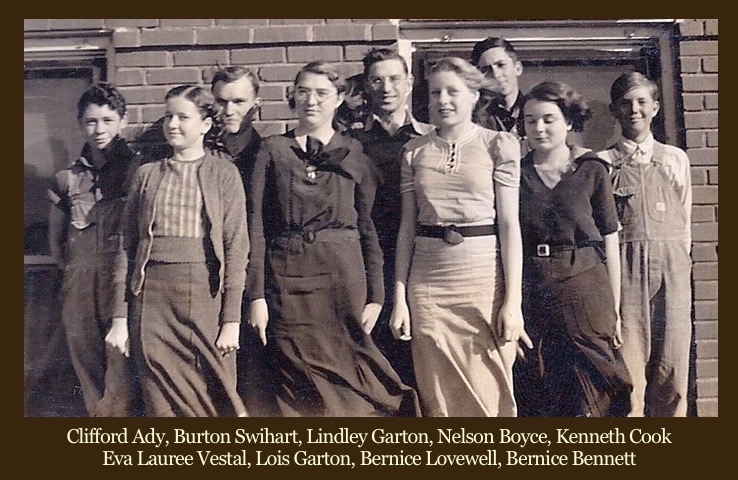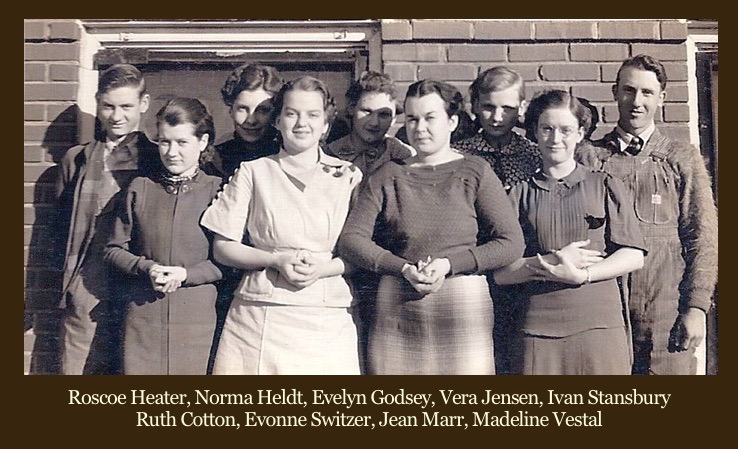We have too much stuff lying around the house and really need to get rid of most of it. Then again, occasionally I run across something that my parents saved or my wife’s parents tucked away for safekeeping which I’m glad no one put out with the trash.
A few years ago I found one of my dad’s report cards and the yearbook from Sinclair Rural High School for 1937, the year he graduated. From the report card I learned that he had a solid “B” average. The yearbook’s class prophecy predicted a bright future for him as a traveling salesman. He would have enjoyed that, probably even more than the banking career he eventually settled into after the war, after serving in the Merchant Marine for a while and then as a TEC 5 in Europe.
Yearbook photos from that era tend to have a washed-out murky sameness. Most of them could have been pictures of almost anybody, even before being strained through a coarse printing screen to break up the tonal values into clusters of black dots that would survive being run through an offset press.


Fortunately, in 1937 Sinclair was a small, Depression-era high school which needed to save a few bucks. Copies of the yearbook were assembled from pages that must have been cranked out of the same tired mimeograph machine that printed the weekly geography exams. Blank spaces were reserved on some pages for pictures (no more than one each), which were later carefully glued into place. The photographs were quite small, some only about 1” tall by 3” wide, probably snipped from contact prints made from the original camera negatives. The pictures were all taken outdoors, with subjects squinting into the sun, standing in rows shoulder-to-shoulder in front of the two-story brick schoolhouse. Owing to the fact that classes and ball teams at Sinclair were also very small, even such tiny group photos are packed with a surprising amount of detail.
I knew a few of the people in the various photos - my dad, of course, his cousin Wayne Switzer, and Wayne’s sister Evonne who married Myron Intermill in 1945. Evonne, whose name was actually Gladys Evonne, taught at the now-extinct town of Rubens in the early 1940’s after getting her normal certificate from McPherson College. She roomed with Myron’s family during her time as a teacher, meeting her future husband when he came home on leave from the Army. She and Myron farmed along White Rock Creek until the creation of Lovewell Reservoir in 1957 forced them to relocate their farming operation north of Webber. Evonne is the girl in white on the front row, second from the left in the photo above.
The tall girl in a light-colored dress on the front row of students at the top of the page is Dave Lovewell’s aunt Bernice Lovewell (mentioned twice earlier here in “Cousinometry” and “Inquiring Minds”). She was one of Stephen Lovewell’s daughters and one of the two who would marry Poole boys, in this case Elwin Adelbert Poole from Courtland. Having two freshmen named Bernice was too much for the yearbook editor, who sometimes identifies both girls as Bernice Lovewell. I hope I’ve straightened out the Bernice situation. If Dave tells me that his aunt was a petite brunette, then I haven’t. The high-spirited youths in this photo are freshmen, the comparatively sober and studious bunch below them are sophomores. By the time it was the seniors’ turn to pose the whole group was pretty glum.
As I leafed through the record of the scholars of ’37, a few photographs fluttered out and landed on top of the washing machine, where I had taken the yearbook to study it because the light is just about perfect there. I did not have to paste the errant photos back into place; they had simply been stuffed into the margins, and I began to wonder what they were doing there. One of the incidental photos was even smaller than the diminutive class pictures from Sinclair. After fishing a magnifying glass out of the junk drawer for a closer look, I was surprised to realize that I knew exactly what the pictures were and approximately where they had been taken.
They were views of picturesque locales in Normandy photographed, one assumes, a few years before D-Day. I thought I recognized one as the shoreline at Arromanches where the Allies would construct an artificial harbor for landing war materiel to help them retake Europe, and another that seemed to feature the church steeples of Ste. Mere Eglise, made famous in the film “The Longest Day." I wonder sometimes if sprinkling them within the pages of this souvenir from his high school days was my father’s idea of editorial comment, his way of saying, Here’s the rosy picture we dreamed our futures would look like, and then this thing happened.
Probably not. Most of us have so much stuff, and it all has to get crammed somewhere.